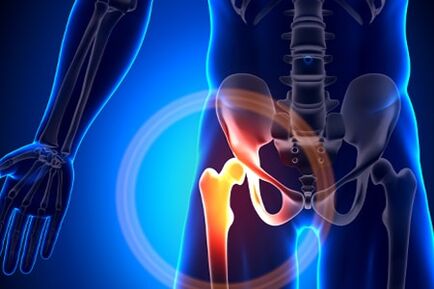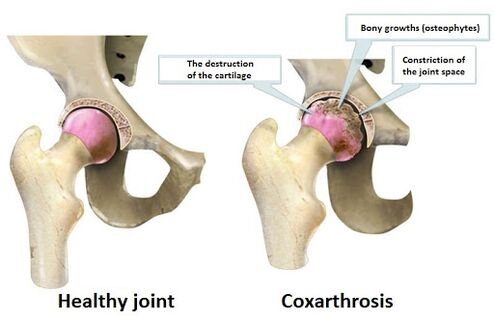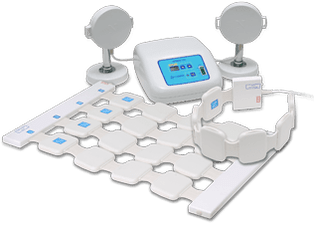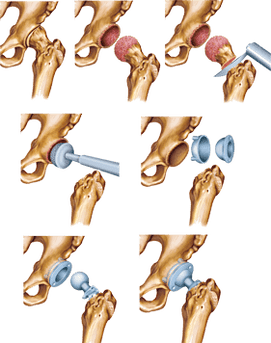
What is this disease with such a complex name - coxarthrosis?.. This disease is a deforming arthrosis of the hip joint and is also often called osteoarthrosis of the hip joint.Coxarthrosis is currently a leader in diseases of the musculoskeletal system, which has a degenerative-dystrophic nature.There are many reasons for the onset of coxarthrosis disease and in this respect this malaise has become widespread in all age groups.
Coxarthrosis belongs to arthrosis that have no inflammatory nature, in which at first there are changes in the degenerative-dystrophic nature in the cartilage of the hip joint, which outlines the surfaces of the joint bones, and in later stages there are already direct bone changes.In the course of such a gradually developing course of coxarthrosis, there is a violation of the naturally normal functions of the affected hip joint, which ultimately leads to impaired function of the musculoskeletal system of a sick person as a whole.
For its greater part, hip arthrosis is suffered by people over the age of forty.Of course, coxarthrosis, like other diseases, seems to be successfully treated without surgery, but only in its early stages.But in the short stages it is unlikely to be done without surgery and only one thing can help to avoid damage - dentures of joint coxarthrosis of the joint.Unfortunately, people, sick people, without being attached to small hip pain in the early stages of the disease, avoid looking for a doctor and osteoarthritis of the hip joint, in the meantime continues to progress on the day after the day, gradually becoming a more represented form.

How Coxarthrosis Develops
Let's look at the mechanism of development of coxarthrosis of the disease.And we start with the fact that the hip joint consists of two bones:
- The end of the most abundant ball -like bone;
- The rotating, similar to a small billiard bush located in the iliac part of the pelvis;
- Special joint cartilage on the surface of the two bones, resembling a substance like a sponge and necessary as a shock absorber, which is compressed during movement and stands in its absence;
- As well as the connections that form the hip cavity itself and thus form the joint capsule.
Surrounded by the joint, in addition, there is muscle tissue, somehow the femur, gluteal and other muscles, on the functionality on which the condition of the hip joint depends.
During the movement, when compression of the articular cartilage, a specific fluid is "squeezed" into the joint, which is a type of lubricant for the bones that are articulated in the joint.Also, the joint cartilage itself, in addition, performs the function of uniform distribution of load on the surface of the joint, and is an excellent shock absorber during movements.
The very appearance of coxarthrosis is mainly due to the fact that the force of the cartilage of the hip joint is disturbed.The cartilage becomes smoother and subsequently disappears into places.If you do not take measures to stop this process, then in those places where the cartoon of the cartilage, described above, the bone itself will grow directly, thus trying to "fill" the void of the joint cavity with it.As a result of such changes in the bones, this is how osteophytes begin to appear, that is, bone spikes.These deformities, in turn, lead to a violation of the bone congregation, which are articulated in the hip joint and the subsequent "abrasion" of the still healthy sections of the articular cartilage.
The causes of hip arthrosis joint
The causes of the coxarthrosis through which it occurs can be divided into primary, with unclear etiology and secondary, as a result of other diseases, for example, such as:
- thigh dislocation, which is congenital;
- femur dysplasia;
- Aseptic necrosis of the femur itself;
- Previously transferred various injuries, such a fracture of the neck of the thigh;
- Is a disease;
- inflammatory processes in the hip joint;
Since coxarthrosis is not only for such, but at the same time, both hip joints are quite possible to say that bilateral coxarthrosis is rare.Although the primary coxarthrosis, the knee joint or the spine is often affected.
Symptoms of coxarthrosis
The first symptoms of coxarthrosis directly depend on the degree of damage to the hip joint as well as on the stage of development of this disease, and the main ones are :::
- Pain manifested during movement, in the hip joint and disappears at rest;
- the occurrence of the lame;
- Stiffness that appeared in the hip joint;
- Progress on the progress of the amplitude of the hip movements;
- The weakness of the femur muscles and the noticeable decrease in their volume.
We separately consider the symptoms of coxarthrosis depending on the degree of the disease with this disease:
- Symptoms of the 1st degree of coxarthrosis: There are pain in the hip joint that is moderate and only after the joint has been subjected to intense load for a long time.After removal of load and rest, this syndrome is completely stopped.In the first degree, the symptoms of coxarthrosis of the gait remain ordinary and the volume of joint movements does not change.
- Symptoms of the second degree of coxarthrosis: Pain in the hip joint feels more intensive than in the first degree, but in addition they are designed in the region of the inguinal region.Due to the developing muscle atrophy, the knee begins to become ill and the knee and quite often.Sometimes with symptoms of second -degree cments, pain begins to appear at rest and after the load of the affected joint it is already necessary to rest.The loved one begins to appear when running or walking for a long time.At the same time, the strength of the hip muscles is quite reduced and the volume of joint movements is also undervalued.
- Symptoms of the 3rd degree of coxarthrosis: a constantly pronounced hip pain syndrome without passing even after an extremely long rest or constant at rest, even at night.The pain is already completely affected by the entire leg.Against the background of pain, the sick person develops insomnia and various sleep disorders.There is strong atrophy of the thigh muscles, buttocks and lower legs, while the volume of the joint engine is almost minimal.When walking a sick person to move around, he is forced to resort to auxiliary means such as a cane.
If such arthrosis of the hip joint develops only in the hip joint of one leg, then its weakened femur muscles give impetus to the development of the lateral displacement of the pelvis, which is why the length of the legs with the joints affected by coxarthrosis decreases.
Diagnosis of coxarthrosis
The diagnosis of coxarthrosis takes into account the symptoms of coxarthrosis described above, in combination with the obtained data from X -ray examination of the patient.Such a technique provides the possibility of determining not only the degree of coxarthrosis, but also to identify the causes that serve as a catalyst for the development of coxarthrosis.Radiography provides an excellent opportunity to determine the changes that specifically led to injury in the area of the hip joint, which is directly related to the mechanisms of development of coxarthrosis.
In addition to the methods of diagnosis already listed, computed tomography and magnetic resonance imaging methods can be used, which provides an opportunity for a thorough detailed study of developing pathology, such as bone tissue, the deformity of which is a satellite of this disease.As for the magnetic resonance imaging, this method still allows the evaluation of the pathological disorders that have been subjected to the soft tissues around the joints affected by coxarthrosis.

Treatment of hip arthrosis joint
The choice of treatment for coxarthrosis depends directly on the symptoms of this disease and its stage.Usually, in the first and second degree of arthrosis of the hip joint, a traditional conservative drug therapy, consisting of the administration of chondroprotectors, vasodilating drugs and, according to indications, also muscle relaxants, is performed.In the period when coxarthrosis is particularly acute, non -steroidal anti -inflammatory drugs are also used.It should be borne in mind that such treatment should be performed by a specialist, since drug self -medication, unlike traditional medicine, can have an extremely negative effect on the patient's internal organs and completely suppress the ability to restore hyaline cartilage.
Also, with arthrosis of the hip joint, various physiotherapy procedures and exercises are prescribed.
Particularly effective, combined with the traditional drug treatment of hip arthrosis, is the use of the magnetotherapy method.The method of magnetotherapy in the early stages is particularly effective - it avoids dystrophic changes and returns the disease back.In the short stages, the method increases productivity and quality of life, reduces the risk of complications in the affected joint.
Impact on the body of the patient with coxarchosis has no direct therapeutic effect with a diet, but recommends that obese people reduce body weight, as it allows to reduce the load on the affected joint, thus facilitating the acute symptoms of coxarthrosis.

As for the third degree of coxarthrosis, the symptoms of which are most painless, treatment as such is performed only through surgery, for example, the endoprothetic of the hip joint is performed.
The endoprosthesis includes components that are functional analogues of the hip joint.This orthopedic product is installed inside the limb, which is determined by its name (endo - from the Greek "inner").An artificial hip substitute performs a musculoskeletal function, but unlike the natural joint, no lubricating fluid appears in it.Yes, it is not required as this prosthesis is made of materials that without any lubrication slide easily and do not destroy.
Statistics show that after surgery, the absolute restoration of limb functions with the deformation of hip arthrosis is achieved in 95% of cases, which allows it to subsequently lead a rather active lifestyle.
The life of such a prosthesis is about 15 ... 20 years, but at the end of his service a second operation is required to replace the worn endoprosthesis.
Please noteIt's important!Do not diagnose!In the case of symptoms of coxarthrosis, you should consult an orthopedic physician, as only a qualified specialist can make the right diagnosis and prescribe the most optimal treatment.
Prevention of coxarthrosis
Coxarthrosis disease can also be avoided if the necessary prevention of coxarthrosis is performed:
- mandatory and timely treatment of joint diseases that are inflammatory;
- Timely treatment of joint dysplasia;
- Mandatory proper and reasonable physical activity, especially exercises with weights that must be done properly;
- Mandatory control of your body weight, with its maintenance normally;
- Prevention of joint injuries.


















